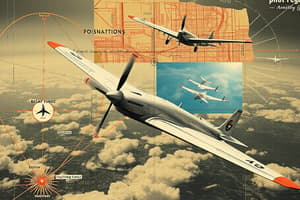Podcast
Questions and Answers
An operable 4096-code transponder with an encoding altimeter is required in which airspace?
An operable 4096-code transponder with an encoding altimeter is required in which airspace?
- Class A, Class B (and within 30 miles of the Class B primary airport), and Class C. (correct)
- Class D and Class E (below 10,000 feet MSL).
- Class D and Class G (below 10,000 feet MSL).
An operable 4096-code transponder and Mode C encoding altimeter are required in?
An operable 4096-code transponder and Mode C encoding altimeter are required in?
- Class E airspace below 10,000 feet MSL.
- Class B airspace and within 30 miles of the Class B primary airport. (correct)
- Class D airspace.
When operating under VFR below 18,000 feet MSL, unless otherwise authorized, what transponder code should be selected?
When operating under VFR below 18,000 feet MSL, unless otherwise authorized, what transponder code should be selected?
- 7700
- 7600
- 1200 (correct)
When operating the transponder on the VFR code (1200), what is the minimum mode the transponder must be in?
When operating the transponder on the VFR code (1200), what is the minimum mode the transponder must be in?
If Air Traffic Control advises that radar service is terminated when the pilot is departing Class C airspace, the transponder should be set to code?
If Air Traffic Control advises that radar service is terminated when the pilot is departing Class C airspace, the transponder should be set to code?
With certain exceptions, all aircraft within 30 miles of a Class B primary airport from the surface upward to 10,000 feet MSL must be equipped with?
With certain exceptions, all aircraft within 30 miles of a Class B primary airport from the surface upward to 10,000 feet MSL must be equipped with?
Each person operating an aircraft equipped with ADS-B Out must operate this equipment?
Each person operating an aircraft equipped with ADS-B Out must operate this equipment?
What type of ADS-B Out equipment is required for aircraft operating below 18,000 feet MSL when flying in Class C airspace?
What type of ADS-B Out equipment is required for aircraft operating below 18,000 feet MSL when flying in Class C airspace?
For operations of an aircraft in Class C airspace with inoperative ADS-B Out equipment, a request must be made to the ATC facility having jurisdiction over the airspace?
For operations of an aircraft in Class C airspace with inoperative ADS-B Out equipment, a request must be made to the ATC facility having jurisdiction over the airspace?
ADS-B Out equipment broadcasts the aircraft's?
ADS-B Out equipment broadcasts the aircraft's?
Unless otherwise authorized, which situation requires ADS-B?
Unless otherwise authorized, which situation requires ADS-B?
When making routine transponder code changes, pilots should avoid inadvertent selection of which codes?
When making routine transponder code changes, pilots should avoid inadvertent selection of which codes?
When making routine transponder code changes, pilots should avoid inadvertent selection of which code?
When making routine transponder code changes, pilots should avoid inadvertent selection of which code?
Unless otherwise authorized, if flying a transponder equipped aircraft, a pilot should squawk which VFR code?
Unless otherwise authorized, if flying a transponder equipped aircraft, a pilot should squawk which VFR code?
If you are operating a glider equipped with a 4096-code radar beacon transponder and not in contact with an ATC facility, what is the transponder code you should be operating on (squawking)?
If you are operating a glider equipped with a 4096-code radar beacon transponder and not in contact with an ATC facility, what is the transponder code you should be operating on (squawking)?
When a distress or urgency condition is encountered, the pilot of an aircraft with a coded radar beacon transponder, who desires to alert a ground radar facility, should squawk code?
When a distress or urgency condition is encountered, the pilot of an aircraft with a coded radar beacon transponder, who desires to alert a ground radar facility, should squawk code?
Study Notes
Transponder and ADS-B Requirements
- Operable 4096-code transponders with encoding altimeters are mandatory in Class A, Class B airspace (within 30 miles of primary airport), and Class C.
- Class B airspace requires an operable 4096-code transponder and Mode C encoding altimeter.
- Under VFR below 18,000 feet MSL, the standard transponder code to select is 1200.
- When using the VFR code (1200), the transponder must operate in Mode A.
- Upon ATC radar service termination in Class C airspace, the transponder should be set to code 1200.
- All aircraft within 30 miles of a Class B primary airport must have ADS-B Out equipment, unless exceptions apply.
- ADS-B Out must operate in transit mode at all times for aircraft equipped with it.
- For operations below 18,000 feet MSL in Class C airspace, aircraft must use either 1090-ES or Universal Access Transceiver for ADS-B Out.
- Requests for operations with inoperative ADS-B Out equipment can be made to ATC at any time.
- ADS-B Out broadcasts the aircraft's three-dimensional position and velocity.
- Overflying Class C airspace below 10,000 feet MSL necessitates ADS-B unless authorized otherwise.
- Pilots should avoid inadvertently selecting transponder codes 7500, 7600, and 7700 during routine code changes.
- When changing transponder codes, avoiding code 7500 is particularly important.
- The VFR code to squawk for a transponder-equipped aircraft is 1200, unless otherwise authorized.
- Glider pilots with 4096 code transponders, not in ATC contact, should squawk 1202.
- Use code 7700 on a coded radar beacon transponder to signal a distress condition to ground radar facilities.
Studying That Suits You
Use AI to generate personalized quizzes and flashcards to suit your learning preferences.
Description
Test your knowledge on the transponder and ADS-B requirements for different classes of airspace. This quiz covers essential regulations for pilots and helps reinforce important safety protocols. Ideal for aviation students preparing for certification.



